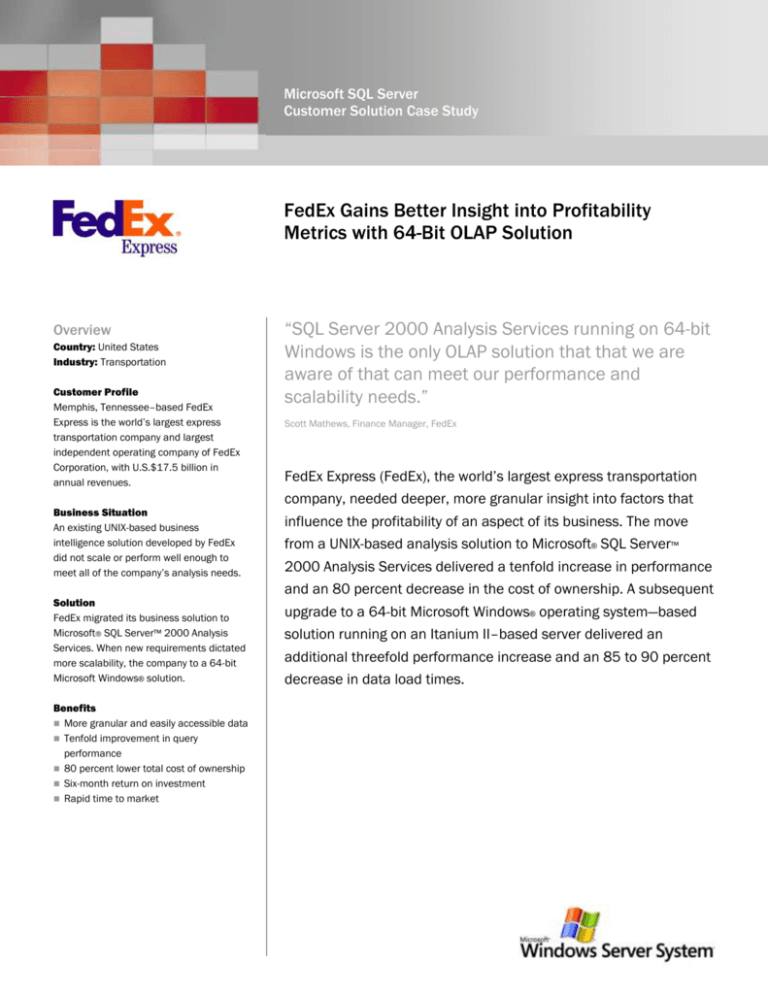
Microsoft SQL Server
Customer Solution Case Study
FedEx Gains Better Insight into Profitability
Metrics with 64-Bit OLAP Solution
Overview
Country: United States
Industry: Transportation
Customer Profile
Memphis, Tennessee–based FedEx
Express is the world’s largest express
transportation company and largest
independent operating company of FedEx
Corporation, with U.S.$17.5 billion in
annual revenues.
Business Situation
An existing UNIX-based business
intelligence solution developed by FedEx
did not scale or perform well enough to
meet all of the company’s analysis needs.
Solution
FedEx migrated its business solution to
Microsoft® SQL Server™ 2000 Analysis
Services. When new requirements dictated
more scalability, the company to a 64-bit
Microsoft Windows® solution.
Benefits
More granular and easily accessible data
Tenfold improvement in query
performance
80 percent lower total cost of ownership
Six-month return on investment
Rapid time to market
“SQL Server 2000 Analysis Services running on 64-bit
Windows is the only OLAP solution that that we are
aware of that can meet our performance and
scalability needs.”
Scott Mathews, Finance Manager, FedEx
FedEx Express (FedEx), the world’s largest express transportation
company, needed deeper, more granular insight into factors that
influence the profitability of an aspect of its business. The move
from a UNIX-based analysis solution to Microsoft® SQL Server™
2000 Analysis Services delivered a tenfold increase in performance
and an 80 percent decrease in the cost of ownership. A subsequent
upgrade to a 64-bit Microsoft Windows® operating system—based
solution running on an Itanium II–based server delivered an
additional threefold performance increase and an 85 to 90 percent
decrease in data load times.
Situation
FedEx Express (FedEx) is the world’s largest
express transportation company, providing
fast and reliable delivery to 215 countries,
including every address in the United States.
The company’s global air-and-ground network
speeds the delivery of time-sensitive shipments—usually in one to two business days—
with the delivery time guaranteed. FedEx
manages 882 operating facilities and 10 air
express hubs, maintains a fleet of 649
aircraft and more than 42,000 motorized
vehicles, and has more than 137,000
employees worldwide.
FedEx uses business intelligence solutions to
make the data in its information systems
available for timely and accurate analysis.
Groups across the business rely on those
analysis solutions to help them make a broad
range of business decisions, including:
SQL Server Fast Facts
Relational Database
Total database size
700 GB
Number of tables
1
Size of largest table
700 GB
Number of rows in largest table
1 billion
Analysis Services
Cube size
150 GB
Number of OLAP cubes
1
Number of dimensions
16
Number of measures
30
Size of largest dimension
More than 1 million members
Dimensions with more than 1,000 members
4
Number of users
150
Performance Gains
Query response after switch from UNIX to 32-bit Windows
(large, noncached query)
900 to 1,000 percent faster
Query response after switch from 32-bit Windows to 64bit Windows (large, noncached query)
300 percent faster
Cube load times after switch from 32-bit Windows to 64bit Windows
85 to 90 percent decrease
Making strategic decisions, such as
whether another FedEx Corporation
company may be able to better serve a
customer.
Analysis of marketing campaigns and how
they affect shipping volumes and
profitability.
Determining special services to offer
selected customers, such as dedicated
account teams or customer service teams.
Several years ago, FedEx deployed a
commercially available online analytical
processing (OLAP) application to help the
company assess costs and improve
profitability. FedEx originally developed and
deployed the business solution on the UNIX
platform. The OLAP system ran on a 12-way
server and required 24 gigabytes (GB) of
RAM. Once per month, FedEx loaded 5 to 8
GBs of new information from its data
warehouse into the business solution, which
maintained a 25-month moving window of
such information. Users queried the business
solution using a Web-based OLAP client.
Although the business solution worked as
intended, FedEx found that the solution could
not scale well enough to support all of the
company’s analysis needs. The solution
began to exhibit data explosion with more
than 7 or 8 cube dimensions, resulting in an
exponential increase in the disk space used.
The result was a rapid falloff in query
performance—a behavior that reduced user
productivity by requiring users to wait several
minutes for the answer to a single question.
As a workaround, FedEx was forced to build
and maintain two separate OLAP cubes.
Because of that separation, the system’s
users could not easily integrate those two
types of information.
In addition to supporting a limited number of
dimensions within a single OLAP cube, the
“Not only did [SQL
Server 2000] Analysis
Services enable us to
load all data into a
single cube, but it also
delivered a tenfold
increase in query
speed.”
Bill Berghel, Finance Advisor, FedEx
UNIX-based solution could not support a large
enough number of members within a single
dimension, which limited the granularity of
data that could be viewed through the
solution. Users could not work at an
individual account level, instead having to
limit their queries to the customer level, even
though a single enterprise customer may
have hundreds or thousands of separate
accounts. In addition, the solution’s limited
scalability had forced FedEx to leave some
desirable business metrics out of the OLAP
cubes entirely.
To meet all of its analysis needs, FedEx
needed an OLAP product that could:
Scale well past the limits of its existing
solution;
Provide greater granularity of data;
Provide more views into the data; and
Support all data within a single cube.
That cube would need to support 30
measures and 16 dimensions—three with
more than 1,000 members, and a fourth with
more than 1 million members. As before, new
data would need to be loaded once per
month—a task that had to be completed
within a weekend to avoid having an impact
on user access. And the solution had to allow
users to create queries based on any 5 or 6
dimensions and still deliver acceptable query
performance.
Solution
FedEx overcame the scalability and
performance limitations of its initial
implementation by switching from a UNIXbased OLAP environment to one based on
Microsoft® Windows Server System™
integrated server software, including the
Microsoft Windows® 2000 Advanced Server
operating system and Microsoft SQL Server™
2000 Analysis Services. The move to Analysis
Services enabled FedEx to put all data in a
single cube and deliver a tenfold increase in
query performance.
Some 18 months later, when new business
requirements demanded an additional large
increase in OLAP performance and scalability,
the company again met its needs by
migrating from a 32-bit Windows solution to
the 64-bit versions of the Microsoft Windows
Server™ 2003 operating system and SQL
Server 2000 running on Intel Itanium II–
based servers. The move to a 64-bit system
delivered a threefold increase in query
performance over the 32-bit system and an
85 to 90 percent reduction in cube load
times, enabling FedEx to rebuild the entire
OLAP cube each month.
The new business solution is proving useful
to a number of groups at FedEx because of
the high degree of flexibility it provides in how
data can be analyzed—enabled in part by
having all data in a single OLAP cube. The
solution is used heavily by 150 power users,
who are distributed throughout the
company’s marketing department, pricing
department, and financial planning and
analysis group, as well as by users who work
for the company’s parent corporation. Data
also is imported to other business analysis
systems for use by additional personnel.
“SQL Server 2000 Analysis Services running
on 64-bit Windows is the only OLAP solution
that we are aware of that can meet our
performance and scalability needs,” says
Scott Mathews, Finance Manager at FedEx.
“With the level of scalability it provides, it
helps determine how we can improve
profitability.”
Switching to SQL Server 2000
Analysis Services
Before switching its solution from a UNIXbased OLAP environment to one based on
“Thanks to SQL Server
2000 Analysis Services,
we now have a much
better, more readily
available understanding
of how certain metrics
affect profitability.”
Scott Mathews, Finance Manager, FedEx
SQL Server 2000 Analysis Services, the
FedEx technology assessment team
investigated different solutions, finding that
SQL Server was the only option that could
meet all of its requirements. The company
examined some proprietary analysis
solutions, but preferred to go with one of a
more open nature so that it could continue to
use its existing Web portal. In addition, FedEx
saw that a move to SQL Server would
significantly reduce the solution’s cost of
ownership.
FedEx brought in an external technology
consultant to assist with the implementation
of the new solution. Steps that were required
included:
1. Setup of the new hardware (an Intel Xeonbased server with four processors and 4
GB of RAM).
2. Installation of Windows 2000 Advanced
Server and SQL Server 2000, including
Analysis Services. (The solution was later
upgraded to Windows Server 2003.)
3. Connection of the new system to the
company’s existing data warehouse—done
by using an ODBC driver for the data
warehouse environment.
4. Use of the graphical tools provided by SQL
Server 2000 to design the OLAP cube and
load it with data.
5. Integration of the new OLAP solution with
the company’s existing Web portal.
Thanks, in part, to the ease of use of Analysis
Services, the consultant had the new solution
up and running in only three days. “The
migration to SQL Server 2000 Analysis
Services couldn’t have been simpler,” says
Mathews. “We had the new solution running
in just a few days.”
Cube size remained approximately the same
as for the previous solution, even though the
new Analysis Solution combined what had
been two cubes into one and added a good
deal more detail, dimensions, and measures.
Analysis Services did not present the same
data explosion issues that the UNIX-based
solution had exhibited in the past.
After Analysis Services was up and running,
FedEx spent a month or so tuning the new
solution. Although the business solution now
contained more information than before and
ran on a smaller, less expensive server, it
delivered a 900 to 1,000 percent
improvement in query performance. Complex
queries that took an hour on the UNIX server
ran in 5 to 6 minutes, while queries that used
to take a minute now ran in 5 to 6 seconds.
“People told us that we would never get
acceptable query performance from a single
cube,” says Bill Berghel, Finance Advisor at
FedEx. “Not only did Analysis Services enable
us to load all data into a single cube, but it
also delivered a tenfold increase in query
speed.”
Exchange Rate Neutralization
Some 18 months after its move to a 32-bit
Analysis Services solution, FedEx decided to
expand its use of its solution to include the
analysis of its international shipments. Not
only would this decision require the loading of
additional data every month, but also the
regular refresh of stored data—as a means of
recalculating the cost of past activities using
current exchange rates.
At the time, FedEx could load a month of data
in 6 to 9 hours, meaning that a full refresh of
the cube would take approximately one
week—an unacceptable amount of time if it
were to remain available to users during
workdays and still deliver fast query
performance. Knowing that the bottleneck
was memory, and that the server already
“Our move to Analysis
Services paid for itself
within six months
through lower
maintenance and
operating costs.”
Scott Mathews, Finance Manager, FedEx
contained the maximum amount of RAM that
Analysis Services could utilize under a 32-bit
architecture, FedEx decided to explore the
migration of its solution to the 64-bit
Windows platform.
To validate that a 64-bit Analysis Services
solution could meet its needs, FedEx
implemented a brief proof of concept. Using
the 64-bit versions of SQL Server 2000 and
Windows Server 2003, Enterprise Edition,
which ran on an HP server with four Intel
Itanium II processors and 32 GB of RAM, the
company proved that it was possible to
refresh a month of data in a single hour. In
addition, the company tested the number of
members it could put into a single dimension,
finding that it could load 3 million customers
without issue. Microsoft Services assisted
with the proof of concept.
Microsoft Services Provides Critical
Support
To help complete the migration to the 64-bit
Windows platform, FedEx again enlisted the
aid of Microsoft Services. During the sevenweek engagement, a Microsoft Services
consultant laid out a solution that first
imported the data from the company’s data
warehouse into a SQL Server relational
database, and then used that database to
load the OLAP cube. He also automated the
cube loading process, tuning it to take full
advantage of all system resources. In
addition, the consultant helped the company
think through its long-term strategy for data
analysis on the Windows platform, sharing
knowledge he thought might be helpful with
FedEx employees.
Today, the business solution resides in the
FedEx data center, alongside other missioncritical business solutions. It runs on an HP
rx4640 server configured with four 1.5-GHz
Intel Itanium II processors and 32 GB of RAM,
which is connected through a fiber-channel
adapter to an EMC CLARiiON storage area
network. Every month, FedEx moves 25 to 30
GB of new data from its 1.4-terabyte data
warehouse into a single table on the 64-bit
server. At any time, that table contains about
700 GB of data in 1 billion rows. Data in the
relational database table is then used to
completely refresh the history in the OLAP
cube, which maintains a size of approximately 150 GB. A full refresh takes 48
hours—longer than during the proof of
concept because the amount of data that
FedEx is loading has continued to grow.
After the cube is refreshed, FedEx moves it to
the old 32-bit Analysis Services environment—since upgraded from Windows 2000
Advanced Server to Windows Server 2003,
Enterprise Edition—for users to access.
Although users still run their queries against
the same server, they are seeing better
performance. FedEx has found that the
additional memory available on the 64-bit
system allows Analysis Services to build a
more highly optimized cube, with query times
that used to take 10 minutes now reduced to
3 minutes.
Benefits
Migration from a UNIX-based analysis
solution to one based on Windows Server
2003 and SQL Server 2000 gave FedEx the
scalability and performance required to meet
all of its data analysis needs. The company’s
move to a 32-bit Analysis Services environment provided users with more flexibility in
how they could analyze and correlate data,
along with more metrics and better query
performance. And when new business needs
demanded even greater scalability, the
company’s move to a 64-bit Analysis Services
solution provided the performance gains
required to apply the same level of granular
analysis to the company’s international
business.
More Granular and Easily Accessible
Data
With its new solution, FedEx can effectively
analyze cost information that is helping the
company to make better, faster decisions on
pricing contracts, marketing campaigns, what
special services to offer customers, and
which FedEx business unit can best serve a
customer. Because of SQL Server 2000
Analysis Services, users can analyze the
forces that affect that profitability in greater
detail and from more perspectives, viewing
the data in a number of ways to better understand how costs are affected by customers,
products, geographies, and other factors.
“Thanks to SQL Server 2000 Analysis
Services, we now have a much better, more
readily available understanding of how
certain metrics affect profitability,” says
Mathews. “Users can do dynamic, ad-hoc
analysis of that data through a readily
accessible Web portal, with enough
dimensions, metrics, and performance at
their disposal to ask new questions or explore
new ideas on the fly.”
Additional Benefits
In addition to providing FedEx with broader
and deeper business intelligence, the
company’s migration to a Windows-based
analysis solution is delivering several other
benefits, some of which include:
Value. Even though Analysis Services
delivers far better scalability and query
performance, its total cost of ownership is
only 20 percent of what FedEx was paying
for its previous UNIX-based solution. “Our
move to Analysis Services paid for itself
within six months through lower maintenance and operating costs,” says Mathews.
Increased user productivity. Improvements
in query performance have made the 150
power users of the Analysis Services
solution far more productive, allowing them
to spend more time asking new questions
and less time waiting for answers.
Reuse of existing IT assets. By supporting
broad standards such as multidimensional
expressions, Analysis Services enabled
FedEx to use its existing Web portal instead
of having to implement a new solution and
train users on a new tool set.
Rapid time-to-market. The ease of use
provided by Analysis Services allowed
FedEx to migrate to the Windows platform
in just a few days, with an additional 3 to 4
weeks spent tuning the solution and taking
advantage of its new capabilities. The
migration from a 32-bit system to a 64-bit
one took about a week—again with FedEx
spending an additional few weeks to take
advantage of the solution’s new
capabilities.
Ease of management. The new business
solution is managed by a single database
administrator, who can access the system
remotely using the Terminal Server feature
of Windows Server 2003.
For More Information
Microsoft Windows Server System
For more information about Microsoft
products and services, call the Microsoft
Sales Information Center at (800) 4269400. In Canada, call the Microsoft
Canada Information Centre at (877) 5682495. Customers who are deaf or hard-ofhearing can reach Microsoft text telephone
(TTY/TDD) services at (800) 892-5234 in
the United States or (905) 568-9641 in
Canada. Outside the 50 United States and
Canada, please contact your local
Microsoft subsidiary. To access information
using the World Wide Web, go to:
www.microsoft.com
Microsoft Windows Server System integrated
server infrastructure software is designed to
support end-to-end solutions built on
Windows Server 2003. It creates an
infrastructure based on integrated
innovation, Microsoft’s holistic approach to
building products and solutions that are
intrinsically designed to work together and
interact seamlessly with other data and
applications across your IT environment. This
helps you reduce the costs of ongoing
operations, deliver a more secure and
reliable IT infrastructure, and drive valuable
new capabilities for the future growth of your
business.
For more information about FedEx Express
products and services, visit the Web site at:
www.fedex.com
For more information about Windows Server
System, go to:
www.microsoft.com/windowsserversystem
Software and Services
Hardware
Microsoft Windows Server System
− Microsoft Windows Server 2003,
Enterprise Edition (32-bit and 64-bit
versions)
− Microsoft SQL Server 2000, Enterprise
Edition (32-bit and 64-bit versions)
Services
− Microsoft Services
Technologies
− SQL Server 2000 Analysis Services
© 2005 Microsoft Corporation. All rights reserved. This case
study is for informational purposes only. MICROSOFT MAKES NO
WARRANTIES, EXPRESS OR IMPLIED, IN THIS SUMMARY.
Microsoft, Windows, the Windows logo, Windows Server, and
Windows Server System are either registered trademarks or
trademarks of Microsoft Corporation in the United States and/or
other countries. All other trademarks are property of their
respective owners.
Document published May 2005
HP rx4640 server with four Itanium II 1.5GHz processors and 32 GB of RAM
(handles cube loading)
Dell PowerEdge 6600 server with 8 Intel
Xeon processors and 4.5 GB of RAM
(supports user queries)






